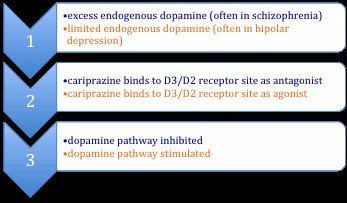Trade names Vraylar ATC code N05AX15 (WHO) Bioavailability High Molar mass 427.411 g/mol | Routes ofadministration By mouth (capsules) Legal status US: ℞-only Protein binding 91–97% | |
 | ||
Cariprazine (trade name Vraylar, previously known as RGH-188) is an antipsychotic drug developed by Gedeon Richter. It acts as a D2 and D3 receptor partial agonist, with high selectivity towards the D3 receptor. Positive Phase III study results were published for schizophrenia and mania in early 2012, and for bipolar disorder I depression from a Phase II trial in 2015. Action on the dopaminergic systems makes it also potentially useful as an add-on therapy in major depressive disorder
Contents
Rights are currently owned by Gedeon Richter and Actavis. The drug received FDA approval on September 17, 2015.
Medical uses
Cariprazine is approved for schizophrenia and manic or mixed episodes associated with bipolar I disorder. It has also been investigated as a potential adjunct in treatment-resistant major depressive disorder.
Side effects
The most prevalent side effects for cariprazine include akathisia, insomnia, and weight gain. Cariprazine does not appear to impact metabolic variables or prolactin levels, and unlike many other antipsychotics, does not increase the electrocardiogram (ECG) QT interval. In short term clinical trials extrapyramidal effects, sedation, akathisia, nausea, dizziness, vomiting, anxiety, and constipation were observed. One review characterized the frequency of these events as "not greatly different from that seen in patient treated with placebo" but a second called the incidence of movement-related disorders "rather high".
Regarding side effects, the label of cariprazine states, "The possibility of lenticular changes or cataracts cannot be excluded at this time."
Pharmacodynamics
Unlike many antipsychotics that are D2 and 5-HT2A receptor antagonists, cariprazine is a D2 and D3 partial agonist. It also has a higher affinity for D3 receptors. The D2 and D3 receptors are important targets for the treatment of schizophrenia, because the overstimulation of dopamine receptors has been implicated as a possible cause of schizophrenia. Cariprazine acts to inhibit overstimulated dopamine receptors (acting as an antagonist) and stimulate the same receptors when the endogenous dopamine levels are low. Cariprazine’s high selectivity towards D3 receptors could prove to reduce side effects associated with the other antipsychotic drugs, because D3 receptors are mainly located in the ventral striatum and would not incur the same motor side effects (extrapyramidal symptoms) as drugs that act on dorsal striatum dopamine receptors. Cariprazine also acts on 5-HT1A receptors, though the affinity is considerably lower than the affinity to dopamine receptors (seen in monkey and rat brain studies). In the same studies, cariprazine has been noted to produce pro-cognitive effects, the mechanisms of which are currently under investigation. An example of pro-cognitive effects occurred in pre-clinical trials with rats: rats with cariprazine performed better in a scopolamine-induced learning impairment paradigm in a water labyrinth test. This may be due to the selective antagonist nature of D3 receptors, though further studies need to be conducted. This result could be very useful for schizophrenia, as one of the symptoms includes cognitive deficits.
Cariprazine has partial agonist as well as antagonist properties depending on the endogenous dopamine levels. When endogenous dopamine levels are high (as is hypothesized in schizophrenic patients), cariprazine acts as an antagonist by blocking dopamine receptors. When endogenous dopamine levels are low, cariprazine acts more as an agonist, increasing dopamine receptor activity. In monkey studies, the administration of increasing doses of cariprazine resulted in a dose-dependent and saturable reduction of specific binding. At the highest dose (300 μg/kg), the D2/D3 receptors were 94% occupied, while at the lowest dose (1 μg/kg), receptors were 5% occupied.
Pharmacokinetics
Cariprazine has high oral bioavailability and can cross the blood brain barrier easily in humans because it is lipophilic. In rats, the oral bioavailability was 52% (with a dose of 1 mg/kg).
